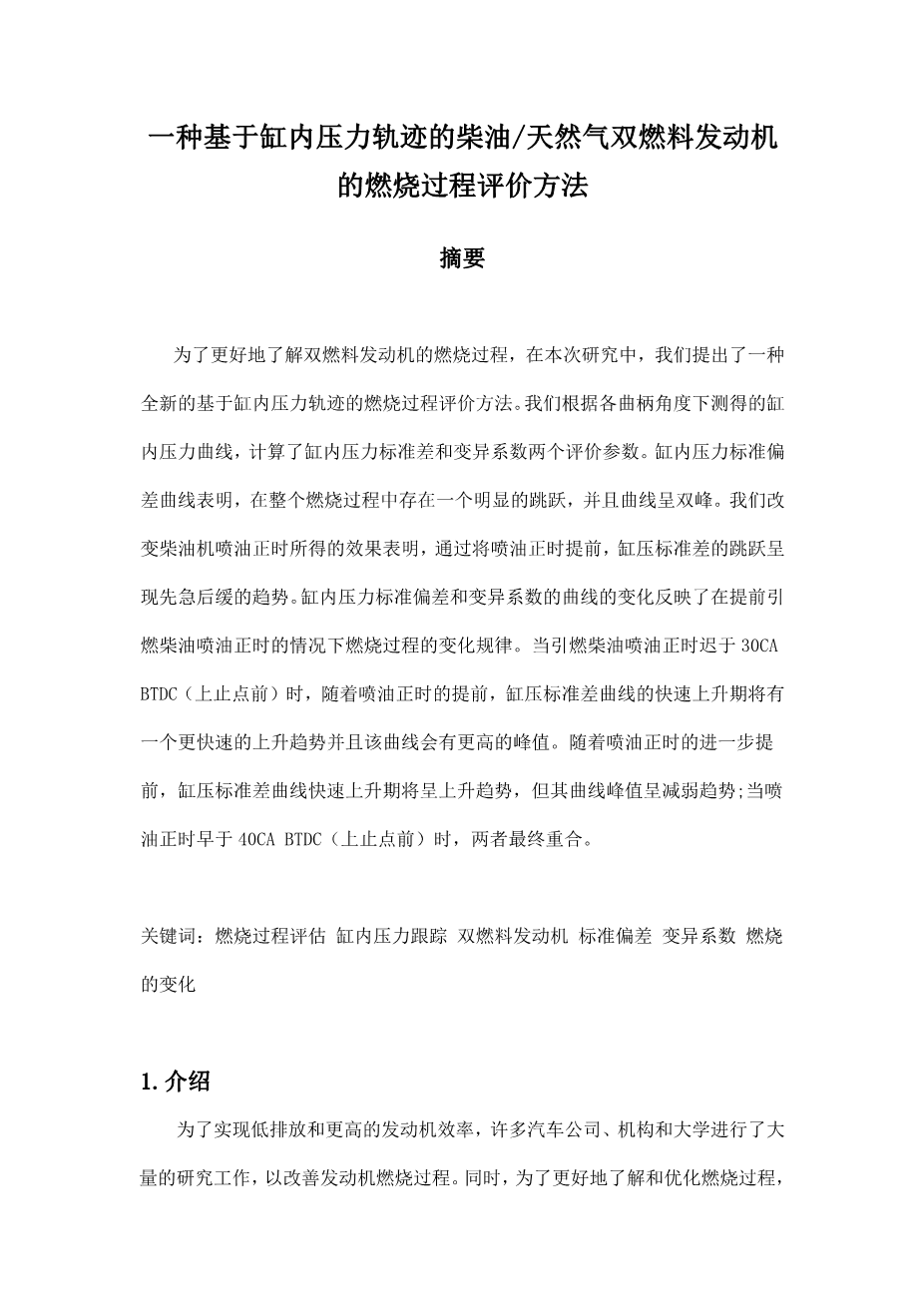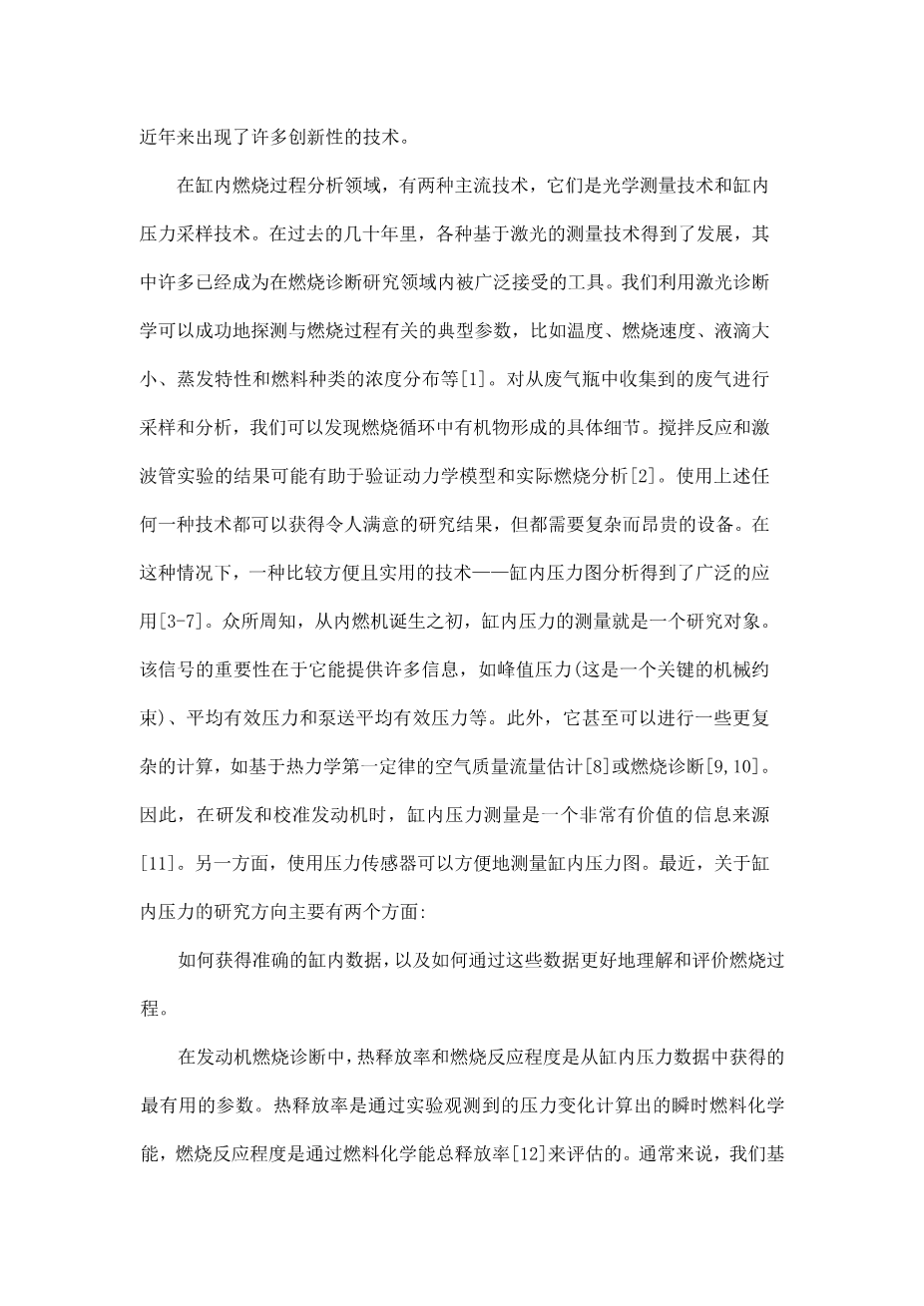一种基于缸内压力轨迹的柴油/天然气双燃料发动机 的燃烧过程评价方法外文翻译资料
2022-08-13 15:42:44
Zhongshu Wang a, Wenjing Chen a, Dan Wang a, *, Manzhi Tan a, Zhongchang Liu a, Huili Dou b
|
Article history: Received 16 December 2015 Received in revised form 26 May 2016 Accepted 6 September 2016 Keywords: Combustion evaluation In-cylinder pressure trace Dual fuel engine Standard deviation Coefficient of variation Combustion variation |
To better understand the combustion process of the dual fuel engines, a novel evaluation method based on the in-cylinder pressure traces was proposed in this study. Two evaluation parameters, the in-cylinder pressure standard deviation and the coefficient of variation, were calculated from the measured incylinder pressure traces at every crank angle. The profile of in-cylinder pressure standard deviation shows that there is an obvious jump representing the overall combustion process. The effect of diesel injection timing shows that, by advancing diesel injection timing, the start of jump shows an initial advancing and then retarding trend. The profiles of in-cylinder pressure standard deviation or coefficient of variation show the change of combustion process as the pilot diesel injection timing is advanced. When the pilot diesel injection timing is later than 30CA BTDC, there is a rapid rise and a higher main peak in the profiles of in-cylinder pressure standard deviation with the injection timing advancing. As the diesel injection timing is further advanced, the initial rapid rise shows an increasing trend while the main peak shows a weakening trend; and both of them finally overlap together when the diesel injection timing is earlier than 40CA BTDC. copy; 2016 Elsevier Ltd. All rights reserved. |
a State Key Laboratory of Automotive Simulation and Control, Jilin University, Changchun 130025, China b China FAW Group Cooperation Ramp;D Center, Changchun 130011, China
|
a r t i c l e i n f o |
a b s t r a c t |
1. Introduction
To achieve ultra-clean and higher engine efficiency, many automobile companies, institutions, and universities have undertaken enormous research efforts to improve engine combustion process. Meanwhile, in order to better understand and optimize combustion process, many innovative techniques have emerged recently.
With a focus on the in-cylinder combustion process analysis, there may be two mainstream techniques, including the optical measurement and the in-cylinder pressure sampling techniques. Various laser-based measurement techniques have been developed during the past decades, and nowadays many of them have become well-accepted tools for combustion diagnostics. Typical combustion-related properties that can be successfully probed by the use of laser diagnostics are, for example, temperature, velocity, droplet size, evaporation characteristics, and species distribution/
|
* Corresponding author. E-mail address: wangdanjlu414@163.com (D. Wang). http://dx.doi.org/10.1016/j.energy.2016.09.030 0360-5442/copy; 2016 Elsevier Ltd. All rights reserved. |
concentration [1]. The sampling and analysis of gases collected from the cylinder can give quantitative details on the formation of organic species during the combustion cycle. Results may contribute to validation of kinetic models and practical combustion analysis, performed with a stirred reaction or shock wave tube [2]. Using any technique mentioned above, a satisfactory research result can be obtained, but all of them require sophisticated and expensive equipment. Under this circumstance, a relatively convenient and practical technique, in-cylinder pressure diagram, is widely used [3e7]. It is well known that the measurement of the in-cylinder pressure has been an object of study from the beginning of the internal combustion engine. The importance of this signal lies on the amount of information that it can provide such as the peak pressure (which is a critical mechanical constraint), indicated mean effective pressure, and the pumping mean effective pressure. In addition, it can even allow some more complex calculations such as air mass flow estimation [8] or combustion diagnosis on the basis of the first law of thermodynamics [9,10]. Thus, in-cylinder pressure measurement is considered a very valuable source of information during the development and calibration stages of the engine [11]. On the other hand, in-cylinder pressure diagram can be easily measured using a pressure transducer. Recently, there are two major aspects regarding the research on in-cylinder pressure:
how to obtain accurate in-cylinder data, and how to better understand and evaluate the combustion process with these data.
In the engine combustion diagnosis, the heat release rate and the combustion reaction extent are the most useful quantities obtainable from the in-cylinder pressure data. The heat release rate is the instantaneous fuel chemical energy calculated by the pressure variations observed experimentally, while the combustion reaction extent is evaluated through the released fraction of the total fuel chemical energy [12]. Usually, the heat release rate is calculated using the first law of thermodynamics and some simplified assumptions. For the pilot diesel ignited natural gas dual fuel engines, the calculation of heat release rate faces more significant challenges due to the uncertainty of the initial heat release process by the dual fuel. Relevant research shows that the heat release in a dual-fuel engine is expected to be different from those in both the natural-gas engine and the diesel engine. The combustion heat release for the dual-fuel engine can be considered to consist of three distinct ph
剩余内容已隐藏,支付完成后下载完整资料


英语译文共 22 页,剩余内容已隐藏,支付完成后下载完整资料
资料编号:[236051],资料为PDF文档或Word文档,PDF文档可免费转换为Word




